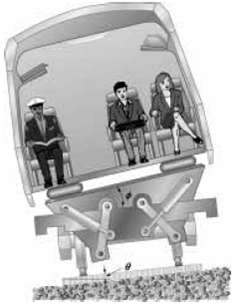Tests carried out with the tilting trains described in Prob. 12.54 revealed that passengers feel queasy when
Question:
Tests carried out with the tilting trains described in Prob. 12.54 revealed that passengers feel queasy when they see through the car windows that the train is rounding a curve at high speed, yet do not feel any side force. Designers, therefore, prefer to reduce, but not eliminate that force. For the train of Prob. 12.54, determine the required angle of tilt ? if passengers are to feel side forces equal to 12 percent of their weights. Problem 12.54: Tilting trains such as the Acela, which runs from Washington to New York to Boston, are designed to travel safely at high speeds on curved sections of track which were built for slower, conventional trains. As it enters a curve, each car is tilted by hydraulic actuators mounted on its trucks. The tilting feature of the cars also increases passenger comfort by eliminating or greatly reducing the side force Fs (parallel to the floor of the car) to which passengers feel subjected. For a train traveling at 125 mi/h on a curved section of track banked at an angle ? = 8? and with a rated speed of 75 mi/h, determine(a) The magnitude of the side force felt by a passenger of weight W in a standard car with no tilt (? = 0),(b) The required angle of tilt ? if the passenger is to feel no side force. (See Sample Problem 12.6 for the definition of rated speed.)
Step by Step Answer:

Vector Mechanics for Engineers Statics and Dynamics
ISBN: 978-0073212227
8th Edition
Authors: Ferdinand Beer, E. Russell Johnston, Jr., Elliot Eisenberg, William Clausen, David Mazurek, Phillip Cornwell





